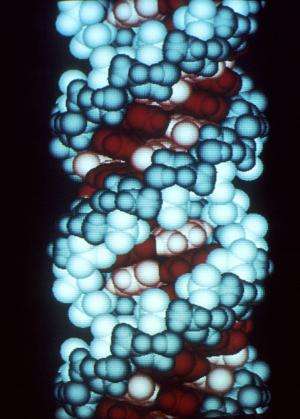October 1, 2015 weblog
Researchers flip riboswitch to kill bacteria

(Phys.org)—A team of researchers working for pharmaceutical company Merck has found an instance of a molecule that is able to flip a switch in a bacterium that prevents it from synthesizing a needed nutrient, and thus kills it. In their paper published in the journal Nature, the team describes the exhaustive study they undertook to find the molecule and the possibility of it one day being used to treat bacterial infections. Thomas Hermann, of the University of California offers a News & Views piece on the work done by the team in the same journal issue.
In order to find new antibiotic drugs, researchers screen many thousands of chemicals to find ones that will work, and, as the researchers with this new effort note, they are almost always proteins. But now, they have found a molecule that is not a protein, but is instead a drug that targets non-coding RNA (ncRNA).
To find the molecule, the researchers used what they describe as a "very smart phenotypic screen" where a host of chemicals were tested to see which ones prevented bacteria subjected to an antibacterial agent from being killed due to the presence of riboflavin (vitamin B2)—bacteria such as e. coli are able to synthesize the vitamin if they can't get it from their surroundings—they need it to survive. They found a single molecule that fit the bill, and called it ribocil. To better understand how it interacted with bacteria, they grew a colony of e. coli that became resistant to its effects and followed that by sequencing their genomes—and that led to the discovery that the bacteria had a non-coding part of their messenger RNA transcript that was involved, which as it turns out, was a riboswitch.
A riboswitch is an element that serves as a regulator at the beginning stages of messenger RNA transcripts—they do their work by binding molecules together which leads to suppressing the expression of a transcript. Close scrutiny of ribocil revealed that it caused just such a riboswitch to be thrown, which resulted in the bacteria dying from a lack of riboflavin. Further testing revealed that ribocil could effectively kill most or all of the bacteria in an infected mouse.
The team notes that while their results were promising, they still don't know if a way can be found to keep ribocil from being ejected by healthy bacteria (they used samples that were weakened), though they will of course continue working to find out. Hermann suggests that the work shows that ncRNA regions in general may serve as targets for other drug efforts, a bright spot among the dismal news of late regarding the development of non-resistant antibacterial drugs.
More information: Selective small-molecule inhibition of an RNA structural element, Nature (2015) DOI: 10.1038/nature15542
Abstract
Riboswitches are non-coding RNA structures located in messenger RNAs that bind endogenous ligands, such as a specific metabolite or ion, to regulate gene expression. As such, riboswitches serve as a novel, yet largely unexploited, class of emerging drug targets. Demonstrating this potential, however, has proven difficult and is restricted to structurally similar antimetabolites and semi-synthetic analogues of their cognate ligand, thus greatly restricting the chemical space and selectivity sought for such inhibitors. Here we report the discovery and characterization of ribocil, a highly selective chemical modulator of bacterial riboflavin riboswitches, which was identified in a phenotypic screen and acts as a structurally distinct synthetic mimic of the natural ligand, flavin mononucleotide, to repress riboswitch-mediated ribB gene expression and inhibit bacterial cell growth. Our findings indicate that non-coding RNA structural elements may be more broadly targeted by synthetic small molecules than previously expected.
Journal information: Nature
© 2015 Phys.org


















